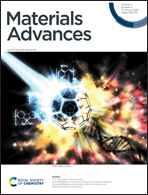The effect of phosphonates on lanthanide separation for surface-grafted porous zirconia†
Abstract
The effect of phosphonate groups on selective lanthanide sorption for a series of inorganic–organic hybrid materials was investigated. Four functional ligands with an increasing number of aminomethylenephosphonate groups were attached to the porous zirconia matrix via the post-synthetic grafting method. Successful surface grafting was confirmed by FTIR and 31P MAS-NMR spectroscopies. All the synthesized hybrids showed a lanthanide uptake of about 100 μmol g−1 at pH 3. The sorption studies revealed that the hybrids of ligands with a larger number of phosphonate groups possess higher selectivity, as one with the largest number showed a separation factor of over 80 for La3+ and Lu3+. Fixed-bed column experiments also demonstrated the materials’ favored uptake of Lu3+ over La3+ at pH 3, in addition to the reusability and applicability to the actual separation settings. These results propose strategies for the selection of organic ligands for hybrid sorbent synthesis.



 Please wait while we load your content...
Please wait while we load your content...